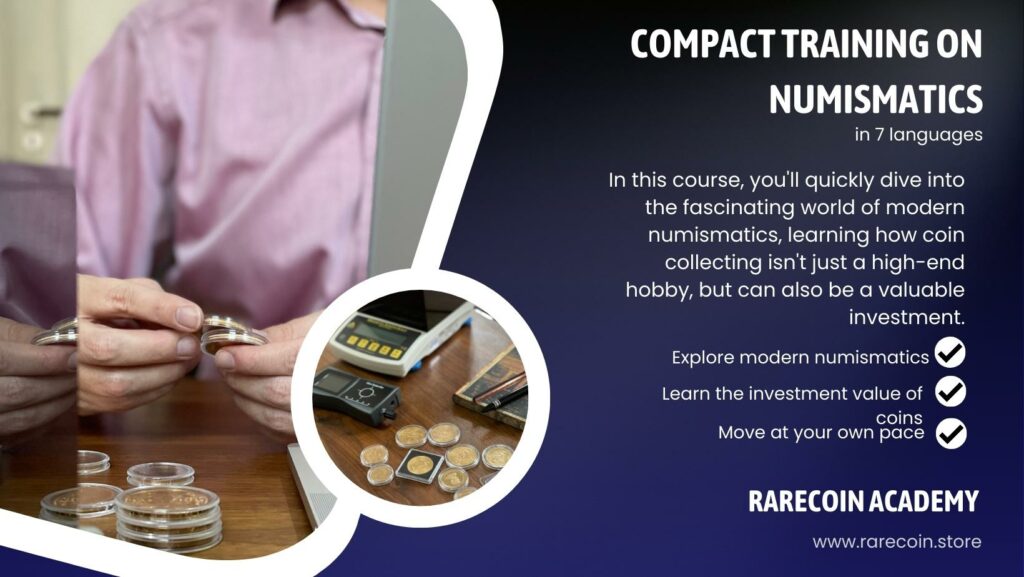
Compact training on numismatics
If you’re short on time but have a burning desire to delve into the fascinating world of modern numismatics, then you’ve come to the right place. Because our course, and that’s what’s special about it, breaks down this very complex topic into bite-sized, manageable lessons that are designed so that you can acquire a little more knowledge every day.
On this exciting journey we will embark on together, we will uncover the captivating secrets of contemporary rare coins. And we won’t just scratch the surface. We will delve deeper and make it clear to you that numismatics is not just a high-end hobby. With the right strategy and clear understanding, it can turn into a real investment that can rival gold in its durability and historical relevance. Although the course is designed in 12 parts, we encourage you to progress at your own pace. So, why hesitate? Let’s start this enlightening adventure together!
By the way, our training has a clear goal in mind: to familiarize you with the basics of coin collecting, with a particular focus on the key elements of modern numismatics.
Please note the addition (*) below!
Introduction to numismatics
Part 1: Understanding the Basics
- Definition of numismatics
- Importance of Coin Collecting
- Development of modern coins
- FAQ on the topics: Definition of numismatics, importance of coin collecting and development of modern coins
Part 2: The Science Behind Coins
- Coin anatomy and terminology (e.g. obverse, reverse, edge, mint mark)
- Coin production: mints, dies and minting processes
- Topic FAQ: The Science Behind Coins
Part 3: Coin Materials and Properties
- Metals used in modern coinage: gold, silver, platinum, copper, etc.
- Factors that determine the value of modern numismatic coins
- FAQ on the topics: Coin materials and properties
Coin valuation and authenticity testing
- Importance of grading in numismatics
- Sheldon Coin Grading Scale Basics
- Understand coin terms (e.g. uncirculated, proof)
- FAQ on the topics: Basics of evaluation
Part 5: Professional Valuation Services
- Introduction to NGC and PCGS
- Advantages of graded coins and encapsulation
- Importance of Coin Authentication
- Common authentication methods and technologies
- Detecting counterfeits and alterations
- FAQ on the topic: Authentication of coins
Coin markets and economics
- Factors influencing coin value: rarity, demand, historical significance, etc.
- Coin price guides and catalogs
- FAQ about coin valuation
Part 8: Coin trading and economics
- Coin Trading Basics
- Economics of Coin Collecting: Inflation, Deflation and the Role of Precious Metals
- FAQ on the topics: Coin trading and economics
Part 9: Building and managing a collection
- Strategies for Building a Diverse Collection
- Techniques for storing and preserving coins
- FAQ on the topics: Building and managing a collection
Dive deeper and expand your knowledge about rare coins
Part 10: World coins and notable coin series
- Coins from major countries: South Africa, Mexico, USA, Australia etc.
- Notable coin series and their significance (e.g. South African Krugerrand, Mexican Libertad, etc.)
- FAQ on the topics: World coins and notable coin series
Part 11: Paper money and exonumia
- Introduction to collecting paper money (notaphilia)
- Exonumia: Understanding tokens, medals and other numismatically related items
- FAQ on the topics: Paper money and Exonumia
Part 12: Community Engagement and Continuous Learning
- Join numismatic organizations and clubs
- Participation in coin exhibitions, auctions and seminars
- FAQ on the topics: Community engagement and continuous learning
Summary
As our compact exploration of modern numismatics draws to a close, we hope you now gain a deeper appreciation and understanding of this fascinating field. From the intricacies of coin anatomy to the economics of coin collecting, each lesson has been curated to provide you with both essential knowledge and specialized insight.
Numismatics is not just about collecting; It’s about connecting with history, understanding the economics, and appreciating the art behind each coin. By now you should have recognized the potential of numismatics not only as a hobby but also as an investment opportunity that reflects the timeless appeal and stability of gold.
Building and maintaining connections within the numismatic community, whether through organizations, clubs or events such as coin shows and auctions, will only enhance your experience. Such engagement provides a platform for continuous learning, exchange and appreciation.
Remember, the world of numismatics is huge and our compact training is just the beginning. Continuous exploration, active participation and a genuine passion for the subject ensure that your journey into numismatics remains enriching and rewarding. Whether you approach it as an investment strategy or simply for the love of coins, may your numismatic adventures always be enlightening and fulfilling. Happy collecting!
Additive (*)
Our Academy content is primarily aimed at beginners, advanced users and generally anyone who would like to delve deeper into modern collector coins or modern numismatics. It is crucial to emphasize that our texts do not claim to be scientifically, historically or socially/politically complete. For a more in-depth look at these aspects, we expressly recommend using appropriate specialist literature, which will enable you to find out more detailed information depending on your area of interest.
The examples given are fundamentally based on our personal experiences and should not necessarily be viewed as generally applicable.
In addition, we ask you to note that the Euro/USD amounts mentioned in our texts reflect the status at the time of creation. As a result, the values of individual coins may have moved up or down depending on the market situation.

